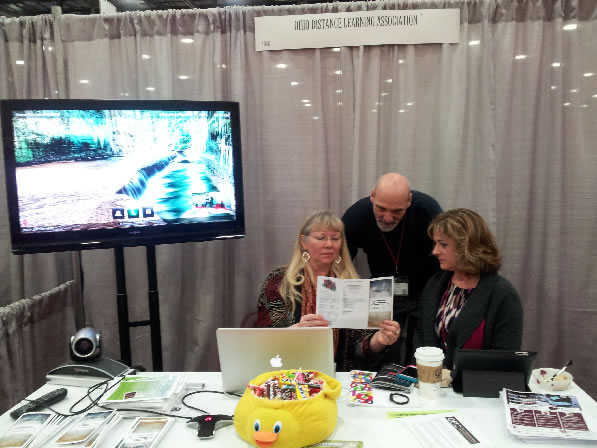HISTORY OF K-12 INTERACTIVE DISTANCE LEARNING IN OHIO
- Home
- > About
Distance Learning
Telecommunity

In 1997, video distance learning began to make an impact on education in Ohio through funding contributions made by Ohio's large local exchange telephone companies as a result of various stipulations and agreements with the Public Utilities Commission of Ohio. By 2003, Ohio Legislature, with Ohio SchoolNet (later known as ETech Ohio) as the implementing agency, had allocated over $28 million in funding to approximately 450 schools, in over 35 telecommunity consortia, for interactive video distance learning projects. The initial telecommunity schools connected through Integrated Services Digital Network (ISDN) and, in some cases, operated as a closed consortia network.
Funds were also allocated for successful telecommunity consortia to add new partners and to continue to support the goals of the consortia and the Ohio telecommunity initiative. Competitive grants became available to provide seed money for Ohio organizations (content providers) to purchase video distance learning equipment and develop K-12 educational lessons that met Ohio school curriculum needs. Many of the original telecommunity consortia, content providers, and eTech Ohio continue to lead the growth of video distance learning in Ohio.
Interactive Video
Distance Learning (IVDL)

In 1998, House Bill 770 established the Interactive Video Distance Learning (IVDL) Pilot to provide public high schools (local, exempted village, city and joint vocational) across the State of Ohio grants so that students and educators can access resources -- information, human, experiences, and electronic -- to improve learning. The overall purposes of the IVDL Pilot were to
- Build different but compatible models of interactive video distance learning that can be studied, modified and replicated
- Pilot an ATM network for voice, video and data transmission
- Enhance teaching and student learning through professional development among all participants
Priority was given to schools in districts that were considered low wealth and in districts without interactive video distance funded through the Telecommunity grant opportunity or other sources. ETech Ohio was the implementing agency for both the Telecommunity and IVDL projects.
Ohio Distance Learning
Organization (OhioDL)

Telecommunity and IVDL consortia were frequently coordinated by educational agencies such as educational service centers (ESCs), educational technology foundation agencies (Ed Techs), information technology centers (ITCs) and urban school districts. The Ed Techs provided the foundation for what was recognized as OhioDL.org by coordinating meetings throughout the year to encourage information sharing and collaboration among the various distance learning consortia and educational agencies. The Ed Techs designed and maintained the initial distance learning website which linked to many Ohio distance learning consortia and content provider websites and provided training materials on equipment usuage and teaching strategies. Eventually, the content from the OhioDL.org website was integrated with the content from the InterCom distance Learning consortium and was managed by the North Central Ohio Educational Service Center (NCOESC). OhioDL.org member agencies and school districts shared the responsibility of maintaining the organization's website and ccordinating meetings throughout the year. The strength of OhioDL.org was built on leadership, collaboration, and the belief that video distance learning could provide real-world opportunities for students and teachers that could positively affect student achievement and professional growth.
ETech
Ohio VNOC

The ETech Ohio Videoconferencing Network Operations Center (VNOC), operated and maintained a state-wide videoconference network providing service to over 1,150 active video network users. The network standards supported video transmission protocols for H.323/IP, H.320/ATM and H.320/Direct connect T-1.
VNOC supported services include
- Video bridging management and operations
- Videoconferencing scheduling
- Consultation and new site registration
- Help desk and technical support
Effective July 1, 2013, the eTech Ohio Commission was renamed and reconstitutesd as the Broadcast Educational Media Commission (BEMC). On that date, all duties and rules of the eTech related to the state's educational broadcasting services, including educational television and radio and radio reading services, were transferred to the new BEMC. Duties that were not transferred to BEMC as a result of this reconstitution were either eliminated or transferred to the Chancellor of the Board of Regents or the Department of Education.
VNOC services were transferred to the new BEMC and continue to support K-12 and higher education videoconferencing services.
Ohio Distance Learning
Association (OhioDLA)

In 2011, the OhioDL.org voted to become an official organization, for the benefit of those districts and content providers we serve. We organized, developed a charter and have become an affiliate of the national organization, United States Distance Learning Association (USDLA). As a state member of this organization, our mission is the same; to promote the use of Video Conferencing in the schools we represent. Some specific goals of OhioDLA include:
- Promoting the growth of video distance learning, web-based learning and hybrid learning among Ohio K-12 enitities;
- Supporting distance learning initiatives impacting Ohio K-12 entities both directly and indirectly;
- Supporting the Distance Learning section of the annual Ohio Educational Technology Conference;
- Educating legislative decision-makers on the impact of distance learning; and
- Seeking funding to support Ohio educational entities using distance learning, not for OhioDLA.
On September 21, 2012, charter members met to establish the offered by-laws of the OhioDLA and define the three types of memberships, which will serve to formalize the structure to promote distance learning in Ohio.




